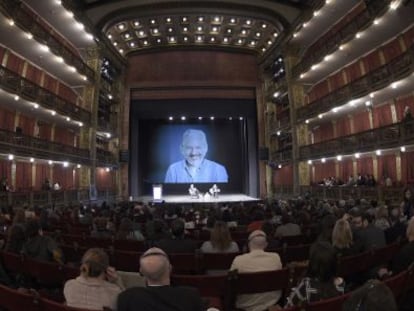Adrian Lamo, the life and death of a hacker with regrets
The family of the man who turned in Chelsea Manning announced his death on Friday. This reporter reveals the conversations he had with Lamo over the course of several years

My first conversation with the hacker Adrian Lamo, who died on March 14, took place in June 2010. Two weeks earlier, the Pentagon had arrested a 22-year-old analyst named Manning, and I had reported on that case, resorting to what little information I was able to glean from my sources at the US Defense Department.
I took an interest in the case because Manning had leaked hundreds of thousands of classified US documents to WikiLeaks, and later boasted about it in a private chat with Lamo, a known American hacker of Colombian descent. I could not then have imagined that EL PA?S would be among the newspapers selected by WikiLeaks to publish the largest ever leak of classified diplomatic cables.
I couldn¡¯t live with the idea of not having done anything
Adrian Lamo
Lamo, who was born in Boston 37 years ago, died last week in Kansas, as his father Mario confirmed on Facebook in a Friday post: ¡°With great sadness and a broken heart I have to let know all of Adrian¡¯s friends and acquittances [sic] that he is dead. A bright mind and compassionate soul is gone, he was my beloved son...¡±
Neither the family nor authorities have revealed the cause of death. WikiLeaks founder Julian Assange immediately tweeted the following message: ¡°Coroner says serial FBI snitch Adrian Lamo is dead. Lamo, a fake journalist, petty conman & betrayer of basic human decency, promised alleged source @xychelsea journalistic protection, friendship and support, then sold him to the FBI.¡± It was the expected reaction.
Coroner says serial FBI snitch Adrian Lamo is dead. Lamo, a fake journalist, petty conman & betrayer of basic human decency, promised alleged source @xychelsea journalistic protection, friendship and support, then sold him to the FBI. https://t.co/SkvbrG7Kyn pic.twitter.com/vZMyJhRWCW
— Defend Assange Campaign (@DefendAssange) March 16, 2018
The story I wrote about Manning, and which I insistently offered to my editors in the summer of 2010, was headlined: ¡®El fanfarr¨®n y el delator¡¯ (or, The show-off and the snitch). Manning had boasted about his leak to Lamo, about whom I wrote that he was ¡°a 29-year-old hacker who was once wanted by the FBI, famous for having broken into the computer networks of The New York Times, altering their databases and adding his name to their list of columnists.¡±
Manning (whose first name is now Chelsea following sex-reassignment surgery) revealed to Lamo that she was the source who had given WikiLeaks a video showing a 2007 helicopter air strike in Baghdad where 12 civilians had died, and of a 2009 air strike against the Afghan locality of Garani that resulted in around 100 civilian deaths.

Faced with a hermetic response from the Pentagon, which would only admit that Manning was in Kuwait awaiting a court-martial, I decided to search for Lamo online. I sent off several desperate messages to all the accounts I could find with the name Adrian Lamo. To my surprise, he replied immediately through a Google service, we briefly chatted through Gmail, and he later phoned me from a private number. Despite being a hacker, and quite adept at covering his tracks, he didn¡¯t seem particularly concerned that the authorities might eavesdrop on what he had to say, as he never once resorted to encrypted communications.
The fact was, Lamo had already shared everything he knew about Manning with the US Army. He told me that it had been a tough decision to make, that he had thought about it for a long time, and that he still had to come to terms with it.
¡°It wasn¡¯t easy, of course it wasn¡¯t easy, but a soldier had given WikiLeaks and who knows how many foreign governments thousands and thousands of classified documents,¡± he told me in perfect Spanish. ¡°Do you know what might be in there? The names of undercover agents, the names of informers, secret locations that may now be attacked.¡±
That conversation produced my first story about Manning on June 10, 2010, which was headlined ¡®Un topo con problemas de autoestima¡¯ (or, A mole with self-esteem issues). That was my first impression of Manning, not because of what Lamo told me, but because of the chat logs of their conversations dating back to May 2010, and which Lamo shared with me. This is how it began:
Lamo told me that he was certain Manning had been deceived by WikiLeaks founder Julian Assange
¡°im an army intelligence analyst, deployed to eastern baghdad, pending discharge for ¡°adjustment disorder¡± in lieu of ¡°gender identity disorder.¡± if you had unprecedented access to classified networks 14 hours a day 7 days a week for 8+ months, what would you do?¡±
Later, Manning boasted about how she was burning information on a CD that he had labeled Lady Gaga, as she was listening to a song by this artist and Beyonc¨¦. On other occasions the conversation revealed great vulnerability, to the point of casting doubt on Manning's mental health.
¡°im very isolated atm¡ lost all of my emotional support channels¡ family, boyfriend, trusting colleagues¡ im a mess ...im in the desert, with a bunch of hyper-masculine trigger happy ignorant rednecks as neighbors¡ and the only safe place i seem to have is this satellite internet connection¡±
Lamo later explained to me that he detected something frivolous and unwitting about Manning, and that this was what led him to turn Manning in: Lamo felt that Manning had not properly gauged the potential effects of cooperating with WikiLeaks. ¡°I don¡¯t think she was aware of what she was doing. I¡¯m sure she wasn¡¯t. It made me very doubtful. What I did was not easy. But she was not a hacker who was moved by ideals, or by a code,¡± he told me.
It was difficult to talk to Lamo. He had Asperger¡¯s syndrome, and had additionally been committed to psychiatric institutions for substance abuse and panic attacks. My conversations with Lamo throughout the years were more like monologues that occurred with no prior warning, on topics ranging from hacking to political crises in Latin America. In fact, following our initial conversation, he disappeared and did not show up again until he found out that EL PA?S was one of the news organizations publishing the WikiLeaks cables, six months later.
During our second conversation, Lamo told me that he was certain ¨C and he wanted me to write it this way ¨C that Manning had been deceived by WikiLeaks founder Julian Assange. The latter, he said, had manipulated a young soldier, making the most of an emotional weakness to steal classified US information and offer it to the nation¡¯s enemies. ¡°Manning will pay, but the culprit is Assange,¡± he said.
Manning was indeed court-martialed, found guilty, and sentenced in August 2013 to 35 years in prison for violation of the Espionage Act. Barack Obama commuted Manning's sentence before handing the Oval Office to Donald Trump, and in the meantime Julian Assange took refuge inside the Embassy of Ecuador in London to evade arrest over rape allegations in Sweden.
Lamo and Manning saw each other face to face only once, in June 2013, during the last weeks of the court-martial at Fort Meade, a military base outside Washington DC. The uniformed soldier, staring straight ahead, teeth clenched, heard the hacker¡¯s reasons for alerting authorities. Lamo did little more than answer the defense and prosecution¡¯s questions, most of the time with yes-no replies. He was evidently uncomfortable. He was now detested by the group of hackers that he had long been a leading member of.
By that time I myself was far away, in Jerusalem, covering other issues for the newspaper. But when I read about Lamo¡¯s testimony, it brought to mind a few snippets of our earlier conversations, the notes of which I still keep.
¡°I couldn¡¯t live with the idea of not having done anything. I am sure that if she¡¯d kept giving information to Assange, many more lives would be in danger,¡± he said. ¡°Now I have to come to terms with myself.¡±
I suspect that he was not very successful at this last task.
English version by Susana Urra.
Tu suscripci¨®n se est¨¢ usando en otro dispositivo
?Quieres a?adir otro usuario a tu suscripci¨®n?
Si contin¨²as leyendo en este dispositivo, no se podr¨¢ leer en el otro.
FlechaTu suscripci¨®n se est¨¢ usando en otro dispositivo y solo puedes acceder a EL PA?S desde un dispositivo a la vez.
Si quieres compartir tu cuenta, cambia tu suscripci¨®n a la modalidad Premium, as¨ª podr¨¢s a?adir otro usuario. Cada uno acceder¨¢ con su propia cuenta de email, lo que os permitir¨¢ personalizar vuestra experiencia en EL PA?S.
?Tienes una suscripci¨®n de empresa? Accede aqu¨ª para contratar m¨¢s cuentas.
En el caso de no saber qui¨¦n est¨¢ usando tu cuenta, te recomendamos cambiar tu contrase?a aqu¨ª.
Si decides continuar compartiendo tu cuenta, este mensaje se mostrar¨¢ en tu dispositivo y en el de la otra persona que est¨¢ usando tu cuenta de forma indefinida, afectando a tu experiencia de lectura. Puedes consultar aqu¨ª los t¨¦rminos y condiciones de la suscripci¨®n digital.










































